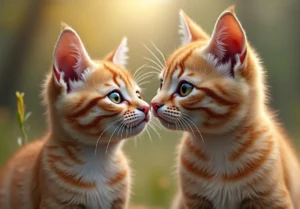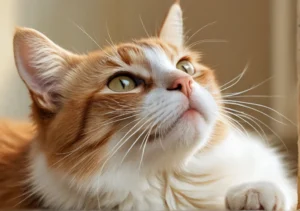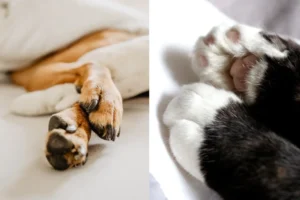Cats are fascinating creatures with a variety of unique characteristics, including their retractable claws. Have you ever wondered why cats’ back claws are dull compared to their front claws?
Evolution of Claws in Cats
Cats have evolved to have sharper front claws for a specific reason: hunting. Their front claws are essential for catching prey, as they use them to grasp and hold onto their victims. In the wild, having sharp front claws is crucial for a cat’s survival, allowing them to effectively capture food.
On the other hand, cats’ back claws have evolved to be duller due to their primary function being for balance and stability. Cats use their back claws for climbing and maintaining their footing, rather than for capturing prey. The dullness of their back claws helps prevent injury during regular activities like climbing trees or jumping onto high surfaces.
Importance of Sharp Front Claws
Sharp front claws are indispensable for a cat’s hunting abilities. They rely on their front claws to catch prey efficiently, making them vital for survival. Additionally, cats use their sharp front claws for self-defense, allowing them to protect themselves from potential threats.
Moreover, sharp front claws enable cats to climb with agility and ease. Whether they are scaling trees in search of prey or seeking refuge from predators, their sharp claws provide the necessary grip and support. In a domestic setting, sharp front claws allow cats to engage in natural behaviors like scratching and stretching, helping maintain their physical and mental well-being.
Tips for Cat Owners:
- Regularly trim your cat’s front claws to prevent them from becoming too sharp and causing injury.
- Provide appropriate scratching posts or surfaces to fulfill your cat’s natural scratching instincts and keep their claws healthy.
- Consider using soft nail caps to protect furniture and prevent accidental scratches while still allowing your cat to exhibit normal scratching behavior.
By understanding the evolutionary reasons behind cats’ sharp front claws and dull back claws, cat owners can better appreciate the unique adaptations that make these feline companions such skilled hunters and climbers.
Rear Claws Function in Cats
Cats’ rear claws serve different purposes compared to their front claws. While the front claws are sharp and used primarily for hunting and self-defense, the back claws are typically dull to help cats maintain balance and stability. These blunt claws act as tiny grips when climbing or leaping, allowing cats to navigate various terrains with ease. So, the dullness of their back claws is actually a clever design feature that enables cats to move gracefully and confidently in their natural environments.
Grooming Habits of Cats
Cats are meticulous groomers, constantly licking and nibbling at their fur to keep themselves clean and free of parasites. This grooming behavior also extends to their claws. When cats groom themselves, they use their teeth and front claws to clean under their nails, but their back claws remain less groomed. Over time, this lack of maintenance can lead to the bluntness of their back claws. However, this bluntness doesn’t hinder their overall agility and dexterity. In fact, it may provide an evolutionary advantage by reducing the risk of self-injury during grooming or play.
Additional Unique Insight:
Here are some additional reasons why cats’ back claws are naturally dull: – Dull back claws prevent cats from accidentally injuring themselves or others during playful interactions. – The bluntness of their rear claws helps cats retract them safely without causing harm. – Cats’ back claws are designed to be less sharp to avoid damaging household items while climbing or playing indoors.
Remember, although cats’ back claws may be dull compared to their front claws, they still serve an essential purpose in the overall function and balance of these graceful creatures.
Physical Adaptations in Cats
Cats have evolved with retractable claws that are exceptionally sharp at the front but comparatively dull at the back. This design is crucial for their hunting and survival in the wild. Cats use their front claws for grasping and climbing while relying on their back claws for balance and traction. The dullness of their back claws helps prevent self-injury during grooming or play, as well as when they stretch. Additionally, the sharpness mismatch between front and back claws aids in climbing and prevents them from getting stuck in surfaces when trying to retreat from dangerous situations.
Other Physical Adaptations in Cats
Apart from their retractable claws, cats boast several other physical adaptations that contribute to their hunting prowess and survival. Some notable adaptations include:
- Exceptional night vision, allowing them to hunt effectively in low light conditions
- Flexible bodies that enable stealthy movements while stalking prey
- Highly sensitive whiskers that help them navigate their surroundings and detect changes in airflow
- Sharp teeth designed for tearing flesh and crunching bones
These physical adaptations collectively make cats formidable predators in their natural habitats.
Declawing Debate
The practice of declawing cats is highly controversial and can have significant negative impacts on their behavior and well-being. Declawing involves the surgical removal of a cat’s claws, which can lead to long-term physical and psychological issues. Cats rely on their claws for multiple functions, including defense, climbing, and stretching. Removing their claws can cause pain, discomfort, and a loss of balance, leading to behavioral problems such as aggression, inappropriate elimination, and avoidance of the litter box.
Impact of Declawing on Cats
Declawing not only affects a cat’s physical abilities but also hampers their natural instincts and behaviors. Some consequences of declawing include:
- Chronic pain and increased risk of arthritis
- Behavioral changes like biting and increased stress
- Difficulty in self-defense and climbing
It is essential to explore humane alternatives to declawing, such as providing scratching posts, nail trimming, and behavior modification training, to ensure the well-being and happiness of our feline companions.
Fun Facts About Cat Claws
Did you know that cats are born with their claws fully developed and retractable, unlike dogs? These retractable claws help them to keep them sharp for hunting and climbing.
Cats have specialized scent glands located in their foot pads, which help them mark their territory by clawing at surfaces. It’s their unique way of communicating and leaving their mark.
Unlike human nails, a cat’s claws are always sharp at the tips but can become dull towards the back. The reason for this is the lack of regular wear and tear on their back claws due to being primarily used for balance and grooming.
Tips for Cat Owners
Keeping your cat’s claws trimmed regularly can help prevent them from becoming too sharp or dull. Invest in a good pair of cat nail clippers and make it a part of your grooming routine.
Providing your cat with scratching posts or pads can help them naturally wear down their claws and prevent them from becoming dull. Encourage your cat to use these surfaces by rewarding them with treats or playtime.
Regularly check your cat’s claws for any signs of damage or infection. If you notice redness, swelling, or discharge, consult your veterinarian for proper care and treatment.
Remember that cats use their claws for various activities like climbing, stretching, and self-defense. Keeping their claws in good shape is essential for their overall health and well-being.
Pro Tip: If you’re unsure about trimming your cat’s claws yourself, seek help from a professional groomer or veterinarian for a safe and stress-free experience for both you and your cat.
Alex, a passionate animal lover, has experience in training and understanding animal behavior. As a proud pet parent to two dogs and three cats, he founded AnimalReport.net to share insights from animal experts and expand his knowledge of the animal kingdom.




